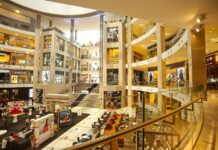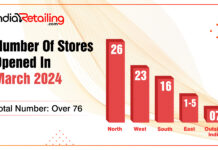Retail industry in India is undoubtingly one of the fastest growing retail industry in the world. It is the largest among all industries accounting to 10 per cent of the country GDP and employs around 8 per cent of the workforce.
The retail industry is an experiential motley that is currently going through a robust transformation. Be it employing new technologies or exploring new store formats, revamping business strategies or creating personal experiences; retailers are indeed getting ready for the future by looking beyond conventional retail and evolving along with their modern consumers.
Increasing urbanisation, digitisation, demonetization, eased FDI norms, GST implementation have impacted Indian retail in a big way in 2017 and will continue to shape the sector further. And because of this both brick-and-mortar and e-commerce majors are planning to be on their toes to decipher consumers consumption behaviour and demand.
India is also expected to become the world’s fastest growing e-commerce market, driven by robust investment in the sector and rapid increase in the number of Internet users.
As the opportunities are immense, let’s take a look what retail trends the stalwarts think will rule in 2018:-
1Kabir Lumba, Managing Director, Lifestyle International Pvt. Ltd.
Seamless Commerce: The customer increasingly is becoming channel agnostic and only those retailers that understand this and can provide a seamless experience for the consumer, both digitally and in the physical stores, making it a definite advantage.
Tech In Offline: consumers today are constantly on the lookout for a retail experience that is both unique and memorable. Incorporating technology that is both interactive and engaging offline is one of the surest ways of ensuring that. Tech in offline is not just about enhancing business functions, it is about enhancing the overall shopping experience for the consumer as well. From consolidating significant consumer insights to identifying trends, the impact of technological inputs in offline retail is already noteworthy when it comes to curating meaningful experiences for the customer.
Value Proposition Getting Stronger: Be it in-store or online, brands that provide a compelling value proposition will thrive. Compelling price points that makes fashion affordable yet aspirational will win.
Global Alignment In Trends and Greater Awareness Among Consumers: The world of fashion, lifestyle and retail will cease to exist in silos and there will be a global alignment in trends which will be enabled due to the greater awareness among consumers. The future of retail will revolve around the faster adoption of trends due to changing lifestyles and easier access to global content on fashion.
More Discipline In Pure Play E-commerce: E-commerce in fashion has come a long way. What started off as a medium for express and easy shopping has now grown into a holistic shopping experience. With more and more consumers accessing fashion online and a certain seamlessness emerging between online and offline trade, it is imperative that the pure-play e-commerce players adopt a more disciplined approach to pricing and promotions.
2Sunil Jindal, Managing Director, SRS Limited
The retail industry has always had a way to surprise all, in its ever volatile fashion of going against the tide and unearthing something unique to set the tone straight. 2018 will also be a game-changer, on the similar lines to its predecessors in the following way:
It is a mobile world: The advancement of app technology and might of Internet has ensured that mobile is a player worth contention. Even in 2018, the role of mobile will continue to act as the glue that binds multiple engagement points together.
Power to the store: Store offering will become a point of differentiation, with marketers opting for experiential ways to engage buyers. Now, staff will become more important as trysts to build a saleable experience shall bear fruit.
Brand and Technology: There is a dire need among retail brands to focus on a clearly defined proposition that provides a USP for shoppers. Here, technology will be the instrument of choice for strategic manipulation.
All Hail Data: Alongside content, data will be a king that marketers need to have by their side. And not just old practices, 2018 will be the year where retailers are set to rethink their data proposition, in order to personalise the customer experience.
A Commerce That Speaks: There is nothing more beautiful and powerful that consumer interaction, and this too will see a change. The incorporation of AI and chatbots will enable brands to direct, automated conversations 24/7.This constant engagement will increase relevance, empowering the art of selling.
In short, 2018 shall be no-short of a success for retailers to cash in.
3Sharad Venkta, MD & CEO – Toonz Retail India Pvt. Ltd.
Personalization and Customer Service: Personalization will be the key differentiator in the retailing of the future. Companies offering highly tailored products and experiences – retailers that have integrated their channels, and can recognize the shopper across touchpoints and offer tailored services, merchandise and promotions, online and offline – will attract more consumers.
Quick Checkout: Frictionless payment is a key component in a seamless shopping experience. The aim is always the same – using technology to make the shopping experience smoother, quicker and safer.
Social e-Commerce: Buy buttons have revolutionized social media from Twitter, to Instagram and Facebook, all the big boys have adopted buttons that invite users to shop on the spot. Far from being a fad, the social commerce trend is expected to intensify.
Power Of Mobile: Retail winners will invest both in m-commerce and in digital channels to aid shopping while in-store. In-store mobility will also translate into mobile Points of Sale (mPOS). mPOS are reaching critical mass in the retail industry, and understandably so, they facilitate interaction with customers, speed up transactions, and help retail staff provide accurate product information on the spot thanks to the access to real-time inventory.
Small is Good!: Small-format stores have been popping up everywhere in the past couple of years; the trend will consolidate. Many retailers, rather than trying to compete with online stores’ large catalog and endless aisles, are taking an inverse approach to survive by becoming small and nimble.
4Rahul Agarwal, CEO, Organic Harvest Company
GST Will Bring Lot of Synergies Between Every Aspect Of The Retail Business:
Retail and FMCG markets in India are rapidly growing and are expected to grow at 20 per cent and 21 per cent per annum according to recent studies published by MRRSIndia.com and ASSOCHAM. Retail sector is the key pillar of Indian economy and it accounts for around 10 per cent of GDP. GST will usher in wide changes in various industries. It will unify the markets as there won’t be state boundaries to hinder their business. GST will streamline their intra-state as well as inter-state transactions. Retailers can expand their business beyond a state with ease due to one-time registration of their business. This will also contribute towards the growth of the retail market and help boost the economy of the country.
Unorganized Retail Will Shift Towards Becoming Organized: Indian retail sector is divided into organised as well as unorganized retail i.e. sale through traditional family or small stores or shops. The part of organised retail in India is still lower than 20 per cent and the large part is shared by unorganized sector. Transaction in the retail sector is done primarily via cash and we have already seen the breakdown of sales amidst demonetization. Post GST implementation, there will not be any major change in sales as consumer behavior would not be altered. Unorganised retail sector would be expected to participate more by coming in mainstream tax paying system. GST on any transaction is unavoidable unless the entire transaction is out of GST system right from manufacturer to retailer.
Digitization Drive Will Increase The Retail Sales: Digitization is playing a key role in communicating what a brand is actually willing to serve its customer. It invades every part of an organisation and develops the way companies build products and services, engages with its customers and market its offerings.
Digitization in retail is no longer about online shopping alone. It has reached far beyond this stage. In today’s connected world, the need to satisfy your tech savvy customers is increasing. It’s important to increase your online presence with a responsive website in order to drive the necessary traffic to your website and direct them to your store.
Digitization is the new benchmark and has become mandatory approach for survival, aid and growth for brands in digital era. The industry leaders are constantly searching ways to innovate with digitization.
Overall Cost Of Retail Business Will Go Down: The logistics costs for companies are expected to go down by 8 to 10 per cent and overall, prices will come down by 1 to 2 per cent.
Many in the industry says, retailers can centralise their storage and supply chain as GST aims to remove the complexity of multiple state and central taxes. The multitude of exemptions ensure a seamless flow of input tax credit in the value chain as it will reduce taxation on most products. If there is pass-through to customers, it will lead to higher consumption of products and is good for everybody in the value chain.
2018 Will Be The Year Of Introduction Of New Brands, Both International And Domestic: 2017 was a year of growth and expansion for both international and domestic market. The year saw launches going full throttle. Brands in cosmetic, skin care, hair colour, hair care and salon tools were seen sprucing up their salon network and at the same time reaching out to people directly via e-commerce operations.
The market size of FMCG in India is estimated to grow to US$ 74 billion in 2018. The personal care industry makes up 22 per cent of India’s market for consumer package goods and experts agree that India is full of opportunities and is a potential gold mine for many beauty and personal care companies. Considering the growth potential of the industry, the internationally renowned brands wants to cater the needs of the beauty, cosmetics and personal care industries.
5 Anupam Arya, Director, Fabriclore
Hybrid Retail Strategy: In recent years, online and offline channels have developed their own niche. While standardized brands will continue to dominate the online space, certain consumer segments which are discrete in touch and feel are increasingly working on a hybrid retail strategy. The more the brand is catering to a niche audience, the more they are likely to go for such a strategy.
Specialized User Experience: With highly focused niche product segments emerging every day, there is a growing need for specialized user experience in order to attract the customers. Online marketplaces, in this case, are incompatible, hence a more tailored shopping experience (both online/offline) is required for promoting such products.
Exploring Tier B and C Cities: While Metros continue to dominate the consumer market space, the next wave of retail growth lies in the urban and semi-urban. Infact, more and more brands have started tailoring their marketing strategies accordingly.
Influencer Marketing: With influencer marketing attracting a lot of eyeballs, lately, more and more brands are shifting from traditional media and trickling down to these influencers. Though the influencers at national level have been quite successful in capturing attention of big brands, there lies a great potential in Regional Influencer Marketing.
Digital Marketing: Trend of small to mid-scale businesses taking advantage of digital marketing is going to continue to spread. Micro segmentation within urban and semi-urban clusters is another area that’s going to remain in trend for success in retail strategy.
6Ambud Sharma, Founder, Escaro Royale Luxury (Escaro.in)
The luxury men’s segment in India is growing rapidly that comprises of apparels, shoes, bags and accessories. In the year 2018, it is expected that the Indian men’s luxury market will further grow and there are several factors that contribute to its growth such as the awareness of luxury brands not only in metros, but also in Tier II and III cities.
‘Luxurious’ Value of Money: Sounds weird right? It isn’t, if you think about it. In India, even the luxury minded customer looks for what value is being offered at what price. That value could be in terms of brand equity or quality or both. The fashion industry will see a lot of value for money from the luxury brands coming in the Indian market in 2018 – basically, high quality products at not so unreasonable pricing. Mostly, a mushrooming large-scale ZARA model is to be predicted.
The Synthetic Luxury Is Here To Stay: With the top luxury brands banning the use of exotic materials – like skins and fur in their products, the same trend is bound to rub off on Indian luxury players as well. The year 2018 is also likely to witness the sales of non-leather goods, thanks to the vegan revolution. The luxury brands in India are more likely to promote fabric based or man-made products for apparel and footwear.
Lots More E-commerce Marketplaces: A lot more luxury brands in India are expected to sell their products on Indian marketplaces such as Flipkart, Myntra and Amazon in 2018 as compared to 2017. Historically, the luxury players have stayed away from marketplaces due to general inefficiencies and brand placement worries. Now they understand the value of high end consumers browsing the pages of Flipkart or Amazon – and how the marketplaces have started to get mature. 2018 will be the year where the luxury brands will see a lot more rendezvous with the marketplaces.
Use Of Internet For Direct Sales: As India adds more and more digital consumers each year, the luxury brands have seen a huge potential in sales and profits by selling to the consumers using their own dedicated websites and apps. For instance, ZARA India launched their website in India in late 2017; so did Tresmode. This trend will gain momentum and more and more luxury players will design and develop their capabilities for direct digital sale in 2018.
Buy Online, Get Offline and Vise-versa!: Most luxury brands offer an immersive experience to their customers. This trend will see an uptick in 2018. More and more companies will invest in technologies that will allow the consumers to buy through cross selling across physical and digital realms. For instance, a consumer can browse the digital catalogue in a store, order online and get the product delivered to their home. Similarly, a customer could browse the product on a website, buy it online and pick it up from a physical store. Better still, buy it from the website and get delivered from a local store (the hyper-local model of fulfilment).
In all, its going to be an exciting year 2018 – let the luxury rain!
7Rashi Menda, Founder & CEO, Zapyle.com
By 2020, e-commerce fashion in India will hit US $30 billion, currently e-commerce fashion industry is valued at US $8 billion.
Omni Platform and Omnichannel Model: According to Google, about 85 per cent of online shoppers start a purchase on one device and finish on another.
Millennials today are present on all devices and browse through products on several platforms online using 2 or more devices. It has become very important for the Ecommerce companies to have seamless UI and UX, where the experience is not compromised. A lot of companies are also changing their approach by being present online and offline – to capture the user behaviour and along with intelligence provide the right match for every user. For instance, Myntra announced all the Mango stores will be managed by them in India.
Chatbots and Personalised Experience: Every user today wants to spend lesser and lesser time browsing, they are no more interested in seeing 1,000s of options before they make the purchase decision. Most of the companies are adopting an experience where a stylists is assigned as a bot to a user on fashion sites, on grocery sites, users are first recommended the products what they have bought multiple times etc. Millennials are familiar with personalised experiences and browsing by limited or curated options. 72 per cent of Millennials said that they do not wish to see more than 50 options before making a purchase decision.
At Zapyle we have personalised the experience for every user by understanding her lifestyle and only show products that fit her preferences.
Faster Checkouts and next day deliveries: Amazon recently made UI changes to its product and reduced the checkout steps, which made the shopping faster by few seconds, but this led to increase in the revenues by US $650 million.
It has become very important for all e-commerce companies to have easy checkout process. In India, online users use COD option out of convenience, Millennials like to spend more time consuming content – watching videos, social media etc.
Even though they are shopping online, they expect their orders to reach next day. Companies should adopt algorithms for warehouse inventory checks as per the pin codes – the products should be dispatched by the nearest warehouse/dispatch centre.
30 per cent of orders are cancelled or not accepted by the users if they are delayed by more than 3 days.
Intelligent Personal Assistant: 42 per cent of the Millennials are using Siri and Google to search content on their devices and this number is expected to grow to 80 per cent by 2020.
Alexa, Siri and Google have changed the way users interact with their devices, soon user would want to search on ecommerce with voice interaction and browse by price, trends and patterns.
Video Content – Online users are spending 72 per cent of their time on digital devices, they are constantly consuming content in the form of videos. Recently Facebook has also started to promote video content. Users have already got used to the concept of browsing products by watching music videos, shop by celebrity looks etc. In future online brands will have to adopt an engaging approach.
8Vishwas Shringi, Founder & CEO, Voylla Fashions Pvt. Ltd.
More power to Tier II towns and cities and metro hubs reach saturation. More choices and easier availability to match matching rise in aspiration and the means to acquire a certain lifestyle.
The continued emphasis on brick and mortar retailing for fashion and lifestyle categories that require a more hands-on experience to ascertain product attributes and differentiators
The dominance of indigenous labels over Western imports. Increasing demand for homegrown wisdom and products, catering to an evolved Indian sensibility across categories. Jewelry, beauty, apparel, even food and beverages. Focus on global-ethnic, distinctive Indian styles and inspiration, with a contemporary outlook.
Lesser spends on ATL as businesses continue to carve out innovative strategies to increase brand visibility offline and online.
Better use of product and services delivery platforms to reach out to consumers. This is especially effective for FMCG brands looking at expanding their presence in newer geographies. For fashion retail, SiS for large format, multi-brand outlets and the Franchise model will continue to drive growth while keeping the costs down.








